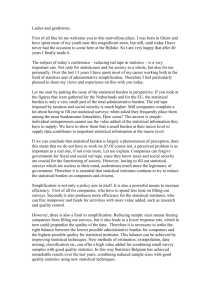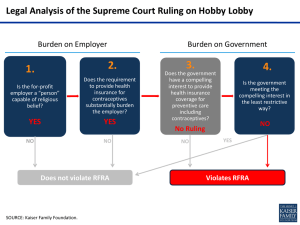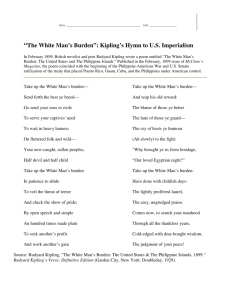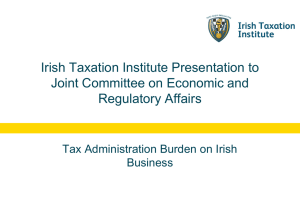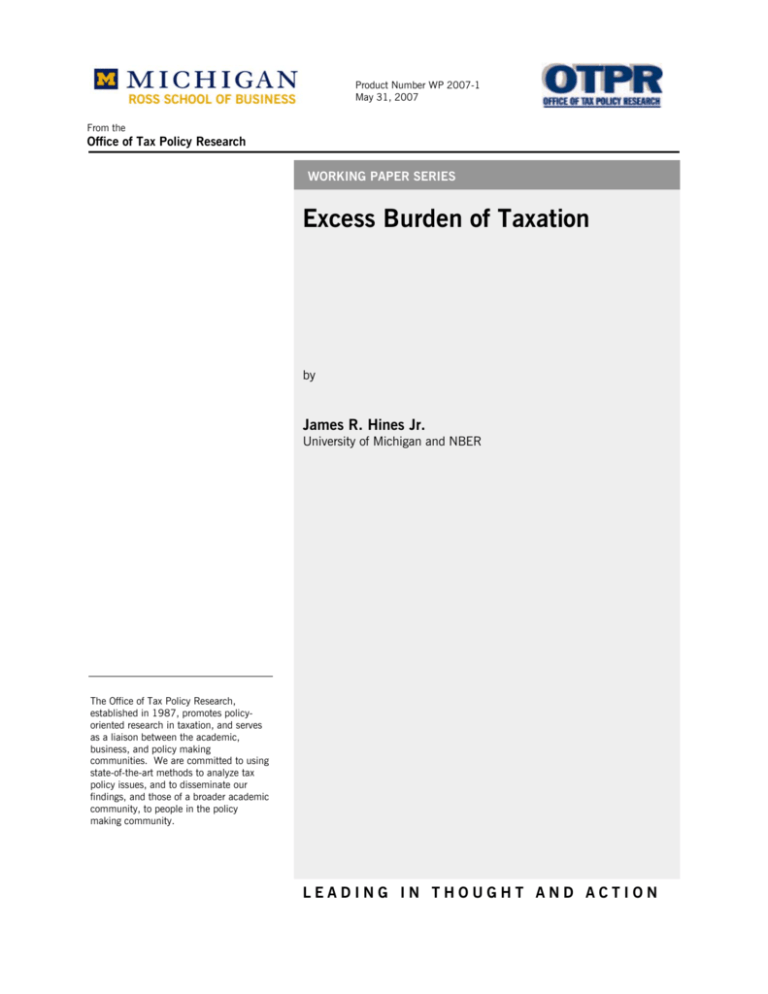
Product Number WP 2007-1
May 31, 2007
From the
Office of Tax Policy Research
WORKING PAPER SERIES
Excess Burden of Taxation
=
=
=
=
by
James R. Hines Jr.
University of Michigan and NBER
The Office of Tax Policy Research,
established in 1987, promotes policyoriented research in taxation, and serves
as a liaison between the academic,
business, and policy making
communities. We are committed to using
state-of-the-art methods to analyze tax
policy issues, and to disseminate our
findings, and those of a broader academic
community, to people in the policy
making community.
=
=
=
=
=
=
=
=
=
=
=
=
LEADING IN THOUGHT AND ACTION
Excess Burden of Taxation
James R. Hines Jr.
University of Michigan and NBER
May 2007
This is prepared as an entry for The New Palgrave Dictionary of Economics, 2nd ed.,
edited by Lawrence E. Blume and Steven N. Durlauf.
©2007 by James R. Hines Jr. All rights reserved. Short sections of text, not to exceed
two paragraphs, may be quoted without explicit permission provided that full credit,
including © notice, is given to the source.
Excess Burden of Taxation
ABSTRACT
The excess burden of taxation is the efficiency cost, or deadweight loss, associated with
taxation. Excess burden is commonly measured by the area of the associated Harberger
triangle, though accurate measurement requires the use of compensated demand and
supply schedules. The generation of empirical excess burden studies that followed
Arnold Harberger’s pioneering work in the 1960s measured the costs of tax distortions to
labor supply, saving, capital allocation, and other economic decisions. More recent work
estimates excess burdens based on the effects of taxation on more comprehensive
measures of taxable income, reporting sizable excess burdens of existing taxes.
JEL Classifications: H21, D61.
James R. Hines Jr.
Department of Economics
University of Michigan
343 Lorch Hall
611 Tappan Street
Ann Arbor, MI 48109-1220
jrhines@umich.edu
1.
Introduction
The excess burden of taxation is the efficiency cost, or deadweight loss, associated with
taxation.
The total economic burden of a tax includes both payments that taxpayers make to the
government and any lost economic value from inefficient activities undertaken in reaction to
taxes. Since direct tax burdens take the form of revenue that taxpayers remit to governments, the
excess burden of taxation is the magnitude of the economic costs of accompanying economic
distortions. For example, a tax on labor income typically discourages work by encouraging
inefficient substitution of untaxed leisure for taxed paid work. At low tax rates this substitution
entails only modest excess burdens, since, in the absence of other distortions, the welfare cost of
substituting an untaxed for a taxed activity simply equals the tax rate, the difference between
pretax and after-tax returns to the taxed activity. At high tax rates this difference is quite large,
and as a result, residents of economies with high tax rates may face substantial excess burdens of
taxation. Indeed, it is entirely possible for the excess burden of a tax to exceed the revenue
collected; a tax imposed at so high a rate that it eliminates the taxed activity clearly has this
feature.
The excess burden of taxation is commonly measured by the area of the associated
“Harberger triangle” (Hines, 1999). The base of the Harberger triangle is the amount by which
economic behavior changes as a result of price distortions introduced by the tax, and the height
of the Harberger triangle is the magnitude of the tax burden per unit of economic activity.
1
2.
The many excess burdens
One of the difficulties that arise in evaluating the excess burden of taxation is that there is
more than one possible measure of excess burden. This multiplicity does not imply that all
measures are equally desirable or useful. For example, the use of uncompensated (Marshallian)
demand and supply curves to construct Harberger triangles produces measures of the excess
burden of taxation with a number of known problems. In the (realistic) case in which a
government uses multiple taxes, a measure of total excess burden based on uncompensated
demand and supply curves is path dependent, meaning that its value depends on the order in
which the taxes are imagined to be imposed. As the order of the taxes is perfectly arbitrary, path
dependence is troubling – most importantly because it reflects the imprecision of excess burden
measures constructed in this way.
Path dependence is one consequence of this imprecision; another is that a tax system that
produces a higher level of economic welfare might have a greater measured excess burden than
an alternative that raises the same revenue. If excess burden is to be useful in the evaluation and
formation of tax policies, it is necessary that the measure correspond, at least approximately, to
the economic cost of taxation – and assign greater excess burden to tax systems that are in fact
more burdensome.
Path dependence and inaccurate welfare orderings need not arise if excess burden is
measured by Hicksian consumers’ surplus, based on schedules that hold utility, rather than
income, constant as prices vary. Because actual tax policy changes typically do not hold utility
constant, it is necessary to construct a measure based on a conceptual experiment that does. One
intuitive experiment is to imagine that, as a tax is imposed, utility is held constant at its pre-tax
level. Excess burden is then defined as the amount, in excess of tax revenue, that the
2
government must compensate consumers to maintain initial utility in the face of a tax-induced
price change. The amount of compensation, which corresponds to the Hicksian measure of the
compensating variation of the price change, may be calculated in roughly the same way that
Harberger triangles are commonly measured.
An alternative conceptual experiment is to begin with the tax already in place and then
remove it, extracting from consumers in lump-sum fashion an amount that prevents them from
changing their utility levels while the tax is removed. Because the initial tax is distortionary, it is
necessary to extract more from consumers than the tax revenue, the difference representing the
excess burden of the initial tax. This differs from the previous measure in corresponding to a
Hicksian equivalent variation measure of excess burden. One virtue of an equivalent variation
measure of excess burden, compared to the compensating variation measure, lies in the fact that,
in comparing tax systems raising equal revenue, the tax system with the lowest excess burden as
measured by equivalent variation also produces the highest level of consumer welfare (Kay,
1980).
Although these compensating variation and equivalent variation measures are the most
intuitive, they are actually just examples drawn from a class of measures based on arbitrary
levels of utility and arbitrary reference price vectors. As King (1983) and others note, the use of
compensated supply and demand schedules together with fixed reference price vectors
guarantees that resulting excess burden measures have desirable properties, though the
interpretation of the resulting magnitudes depends on the choice of utility levels and price
vectors. These measures then can be naturally generalized to include marginal excess burden,
the change in excess burden arising from a given tax change, and to treat excess burden in
settings in which costs of production vary with output levels (Auerbach and Hines, 2002).
3
3.
Empirical measurement of excess burden
While the theory of excess burden measurement has a long and colorful history that dates
back to the nineteenth century contributions of Jules Dupuit (1844) and Fleeming Jenkin
(1871/72), economists seldom measured actual excess burdens prior to the pioneering work of
Arnold Harberger in the 1960s. In two influential papers published in 1964, Harberger (1964a)
derived an approximation used to measure excess burden and (1964b) applied the method to
estimate excess burdens of income taxes in the United States. Harberger shortly thereafter
(1966) produced estimates of the excess burden of U.S. capital taxes. A generation of empirical
studies by other scholars followed the publication of Harberger’s subsequent survey article
(1971).
The empirical work that followed Harberger’s efforts focused on the use of simple excess
burden formulas to estimate the welfare impact of a wide array of tax-induced distortions,
including those to labor supply (Browning, 1975), saving (Feldstein, 1978), corporate taxation
(Shoven, 1976), and the consumption of goods, such as housing and non-housing consumption
items, that are taxed to differing degrees (King, 1983). In addition, some attention was devoted
to refining the approximations used in applying estimated behavioral parameters to calculate
excess burdens. A variant of the excess burden formula used by Harberger, in which a form of
uncompensated demand is used in place of compensated demand, approximates a compensated
measure of welfare change. One question of interest to subsequent investigators is the practical
difference between results obtained using Harberger-style approximations and those available
from more exact measures. As Mohring (1971) and subsequent authors note, it is often the case
that the same demand information necessary to calculate approximations can, if properly
4
modified, be used to calculate Hicksian excess burden measures. The extent to which these two
methods generate different answers is, of course, an empirical question. Rosen (1978) finds that
measures of excess burden based on compensated and uncompensated demand and supply
schedules track each other rather closely, but Hausman (1981) offers some examples in which
they differ considerably.
A major practical difficulty in measuring the excess burden of a single tax, or of a system
of taxes, is that excess burden is a function of interactions that are potentially very difficult to
measure. For example, a tax on labor income is expected to affect hours worked, but may also
affect the accumulation of human capital, the intensity with which people work, the timing of
retirement, and the extent to which compensation takes tax-favored (e.g., pensions, health
insurance, and workplace amenities) in place of tax-disfavored (e.g., wage) form. In order to
estimate the excess burden of a labor income tax, it is in principle necessary to estimate the effect
of the tax on these and other decision margins. Analogous complications are associated with
estimating the excess burdens of most other taxes. In practice, it can be very difficult to obtain
reliable estimates of the impact of taxation on just one of these variables.
It is in reaction to the complicated nature of the problem of separately estimating the
effect of taxation on all of a taxpayer’s decision margins that a number of recent studies estimate
excess burdens based on the effects of taxation on reported taxable income. Taxable income
incorporates not only any effects of taxation on work effort, but also tax avoidance of various
forms, including deliberate hiding of income and legal avoidance such as making tax-deductible
charitable contributions. Properly measured, excess burden as calculated by the effect of
taxation on taxable income should accurately capture all of the necessary interactions to evaluate
the welfare consequences of taxation (Feldstein, 1999).
5
Several empirical studies, including Feldstein (1995), Auten and Carroll (1999), and
Goolsbee (2000), consider the responsiveness of taxable income to tax rates, relying on major
U.S. tax changes to provide variation in tax rates. The evidence indicates that taxable income is
generally quite responsive to tax changes, particularly among the high-income population,
thereby implying an excess burden of U.S. taxes considerably greater than that produced by
studies using estimated effects of taxation on work hours and saving. The estimates suggest
excess burdens of taxation that might be as high as 75 percent of tax revenue collected
(Feldstein, 2006), though there is still considerable uncertainty over its true magnitude.
6
References
Auerbach, Alan J. and James R. Hines Jr. 2002. Taxation and economic efficiency. In
Handbook of Public Economics, vol. 3, eds. Alan J. Auerbach and Martin Feldstein.
Amsterdam: North-Holland, 1347-1421.
Auten, Gerald and Robert Carroll. 1999. The effect of income taxes on household income.
Review of Economics and Statistics 81, 681-693.
Browning, Edgar K. 1975. Labor supply distortions of social security. Southern Economic
Journal 42, 243-252.
Dupuit, Arsène Jules Étienne Juvénal. 1844. De la mesure de l’utilité des travaux publics.
Annales des ponts et chaussées, Second series, 8. Translated by R.H. Barback as On the
measurement of the utility of public works, International Economic Papers, 1952, 2, 83-110;
reprinted in: Kenneth J. Arrow and Tibor Scitovsky, eds., Readings in welfare economics
(Richard D. Irwin, Homewood, IL, 1969), 255-283.
Feldstein, Martin. 1978. The welfare cost of capital income taxation. Journal of Political
Economy 86, S29-S51.
Feldstein, Martin. 1995. The effect of marginal tax rates on taxable income: A panel study of
the 1986 Tax Reform Act. Journal of Political Economy 103, 551-572.
Feldstein, Martin. 1999. Tax avoidance and the deadweight loss of the income tax. Review of
Economics and Statistics 81, 674-680.
Feldstein, Martin. 2006. The effects of taxes on efficiency and growth. NBER Working Paper
No. 12201.
Goolsbee, Austan. 2000. What happens when you tax the rich? Evidence from executive
compensation. Journal of Political Economy 108, 352-378.
Harberger, Arnold C. 1964a. The measurement of waste. American Economic Review 54, 5876.
Harberger, Arnold C. 1964b. Taxation, resource allocation, and welfare. In The role of direct
and indirect taxes in the federal revenue system, ed. John F. Due. Princeton, NJ: Princeton
University Press, 25-70.
Harberger, Arnold C. 1966. Efficiency effects of taxes on income from capital. In Effects of
corporation income tax, ed. Marian Krzyzaniak. Detroit: Wayne State University Press, 107117.
Harberger, Arnold C. 1971. Three basic postulates for applied welfare economics: An
interpretive essay. Journal of Economic Literature 9, 785-797.
7
Hausman, Jerry A. 1981. Exact consumer’s surplus and deadweight loss. American Economic
Review 71, 662-676.
Hines, James R., Jr. 1999. Three sides of Harberger triangles. Journal of Economic
Perspectives 13, 167-188.
Jenkin, Henry Charles Fleeming. 1871-1872. On the principles which regulate the incidence of
taxes. Proceedings of the Royal Society of Edinburgh, 618-631; reprinted in: Sidney Colvin and
J.A. Ewing eds., Papers, literary, scientific, &c. by the late Fleeming Jenkin, vol. 2 (Longmans
Green, London, 1887), 107-121.
Kay, John A. 1980. The deadweight loss from a tax system. Journal of Public Economics 13,
111-120.
King, Mervyn A. 1983. Welfare analysis of tax reforms using household data. Journal of
Public Economics 21, 183-214.
Mohring, Herbert. 1971. Alternative welfare gain and loss measures. Western Economic
Journal 9, 349-368.
Rosen, Harvey S. 1978. The measurement of excess burden with explicit utility functions.
Journal of Political Economy 86, S121-S135.
Shoven, John B. 1976. The incidence and efficiency effects of taxes on income from capital.
Journal of Political Economy 84, 1261-1283.
8





